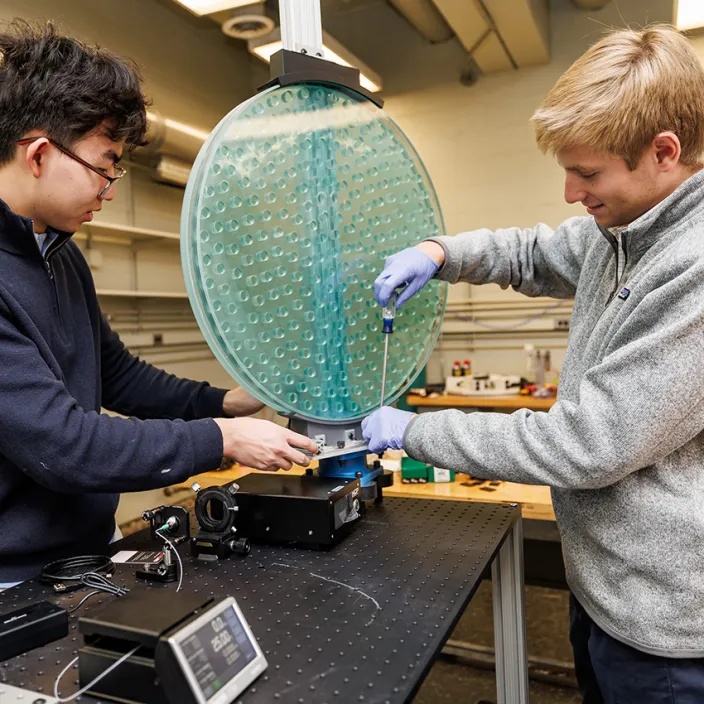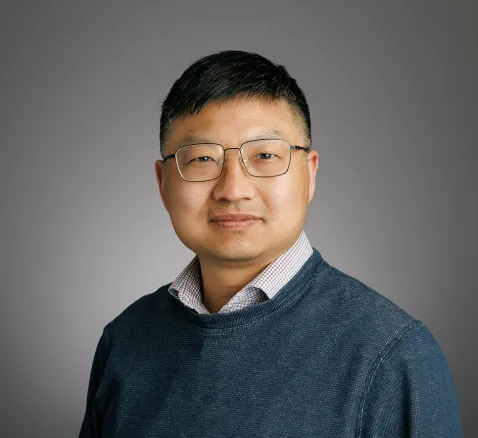Lasers over the Sound
This story originally appeared in Yale Engineering magazine.
Just the setup itself is amazing: Three laser beams shooting out from a telescope atop Kline Tower on Yale’s campus, traveling 44 kilometers over Long Island Sound, to be received by a similar telescope housed on top of a hospital at Stony Brook University.
Even more impressive is the goal of the project, in which Hong Tang and a team of undergraduate students look to expand how quantum information can be sent and received, potentially setting the course for future quantum computing infrastructures.
Read more • Approximately 4 minutes“We want to exchange quantum information to show that a link is possible through free space,” Tang said of the project, self-explanatorily titled Quantum Laser Across the Sound (Q-LATS). After that, they can test it out for other applications, from quantum cryptography to high-resolution images for astronomy, to high-energy particle detection.
Beyond the practical applications of the project, Tang said Q-LATS can serve as an educational vehicle for students to grasp the rather uncanny nature of quantum science. Further, he said, it will engage the public’s interest. The idea of qubits flying over Long Island Sound “will incite the public’s curiosity in quantum sciences and help propel the next generation of engineers and scientists,” Tang and his fellow researchers wrote in a proposal for the project. A third partner in the project, Brookhaven National Laboratory, is linked to Stony Brook’s quantum network through fiber optics.

As Tang sees it, he and his team of researchers are taking advantage of a unique situation.
“In the United States, there are not many places like this, with a body of water in between two major research institutions, and between two different states,” said Tang, the Llewellyn West Jones, Jr. Professor of Electrical & Computer Engineering.
For the project, they will generate a pair of entangled photons (in quantum physics, “entangled” essentially means that the particles are connected, even over very long distances), then shoot them out over the Sound. If all goes right, they’ll still be entangled.
“We keep one of them, and then we send the other through the laser over to the Stony Brook side,” said Mason Abrell (Physics & Global Affairs ’26), co-captain of the student team working with Tang on the project.
Typically, quantum networks use fiber optic cables. Insulated and often underground, it’s a good way to get notoriously fragile qubits—bits of quantum information—to where they’re going. But fiber optics aren’t ideal for every network. There can be geographical limitations, and setting up a network can be pricey. Also, Tang said, you can’t use fiber optics to communicate with a satellite, or with an isolated island.
“With free space optics, you own the free space,” he said. “So in an urban area, you could go from roof to roof, which could be much easier than going underground or going under the ocean.”
Of course, a system involving lasers over Long Island Sound isn’t without its potential hiccups. There’s possible interference from fog, for instance.
“We’re traveling 44 kilometers through free space, which means a lot of air attenuation, diffraction, just turbulence,” Abrell said. “It could be raining, and things like that.”
The setup consists of a few major components: A 25-inch mirror, a telescope, and a dome. The telescope will emit three beams. One is the quantum signal itself, another is for tuning the frequency of the beam, and the third ensures that the course of the beam is correctly aligned. The system will be controlled remotely from Dunham Laboratory on the Yale Engineering campus.
The research team has about $250,000 in funding for the project so far and will apply for a much larger federal grant this year. They hope to have the system ready for testing by summer.
There are, as you can imagine, many tricky parts to sending quantum particles over the Long Island Sound. Extreme precision is one of them, Tang said.

"We need to synchronize the clocks, ours and the clock at Stony Brook,” he said. “That’s kind of a big challenge, to make sure you don’t lose track of the quantum light. It’s more demanding than any computers that you typically use.” In fact, the clocks need to be synchronized within picoseconds of each other. A picosecond is a trillionth of a second.
One unusual thing about the project is that it’s largely powered by the work of seven undergraduate students. Abrell said he learned about it in spring of last year, when Tang mentioned it in passing to him.
“He happened to mention it as a back-burner project that he’s working on,” said Abrell, a physics major. “I was stoked. I was like, ‘How have I not heard about this project?’ It’s incredible because there’s very few projects like it anywhere in the world, really, but especially in the U.S.”
So he called some of his friends who he knew would be interested—physics majors, electrical engineers, and mechanical engineers among them. “We got a team together over the summer, did a lot of design work, making sure we understood what we were doing, and then started ordering parts.”
Christian Kang (Physics ’26), another member of the team, said he was immediately excited by the challenges the project presents.
“While there’s this overarching goal of linking quantum computers together, there’s this more pressing technical challenge: We have this telescope on one end of Long Island Sound and this telescope on the other end, and we need to get them aligned with each other,” he said. “There’s turbulence over Long Island Sound in the air. As the beam travels, it’ll wander back and forth, or it’ll get messed up a little bit. How do we get the information despite all these additional sources of errors?”
Quantum science is famously tricky, but Tang said the undergraduate team is up to the task.
“They are very enthusiastic, and I think it’s good to reach out to a broader range of disciplines of students who are interested in quantum science,” he said. “It’s quite a long-term project. So I would expect that it’s going to last more than five to ten years. There are going to be generations of students that will be trained.”
More Details
Published Date
May 22, 2025


